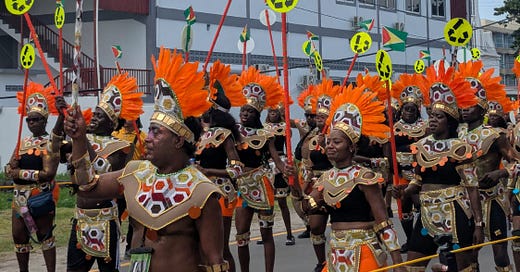On chasing waterfalls in Guyana
Unconventional sightseeing, and why sometimes it's ok to not do The Thing.
Eavesdropping has always been one of my greatest sports. There’s a funny phenomenon in travel land that makes it especially great, whereby native English speakers tend to forget that there might be other people around them who can understand what they’re saying. It happens in most places, but especially in countries like Brazil, say, where the local demographic can be diverse (enough for the other white people in the room not to completely stand out) and where one might safely assume that nobody local speaks much English.
Generally, the less touristy the place, the more unguarded and complacent your lone, common gringo might be when discussing their fungal toenail rot on the phone to their mum, or when bitching about one friend to another. And I’m always listening. What? I’m nosy! It’s part of what led me to become a journalist in the first place.
So it thrilled me to be sitting in the aptly-named Oasis Café during our time in Georgetown, Guyana, recently, inconspicuously eating my poached eggs while surrounded by British and American suits having intense and secretive conversations all around me.
The kind of conversations that produce sentences like: “We’re affirmative about making a deal away from the table”; “The Ambassador for Qatar is here outside right now – this could be a very good opportunity”; and “I said to the guy, call the banker, that’s a lot of oil!” – All genuine phrases I heard in that café in the minutes spent jotting the beginnings of this newsletter down in my notes app.
We happened to time our arrival in the capital for two of the biggest events in the Georgetown calendar: Mashramani, a huge annual carnival marking the day Guyana became a republic, and the Guyana Energy Conference – also huge, drawing in international corporate types from all around the world (the ones getting excited about oil). This was doubly unfortunate for us, since Guyana is an expensive country for a backpacker to be in at any time of year, and with two major events happening at once, most accommodation had already been booked up well in advance.
Add to this the minor stress of not knowing exactly how long we would be staying here for, because there were two key things we hoped to see in Guyana: the famous Kaieteur Waterfalls to the west of the country, and the rainforest to the south – but organising these things was proving nightmarish. Unlike French Guiana, and to a lesser extent Suriname, where we could make a reasonably tight plan for efficiency, Guyana was fast revealing itself as a place where efficiency wasn’t part of the ethos.
Another travel phenomenon: not realising just how crucial it is to your life experience that you see/do a certain thing/place/activity until arriving at it – and then becoming momentarily blinded by the importance of seeing/doing it at the cost of anything else (but mostly money). This is something I often came up against during my first big backpacking trip as a solo 23 year-old, though rationality usually won out in the end.
For example, staying up in the mountains near Semuc Champey, Guatemala, at not inconsiderable expense for me at the time, with the notion of joining everyone else there in going cave diving. I put my name down on the list. I almost handed over a big wad of cash for it. But then when I allowed myself to pause for a moment, I remembered that actually, I hate caves and I hate the feeling of being trapped underground. And just because it’s The Thing everyone does in that particular place… doesn’t mean you have to do it. In the end, I had a lovely day out with two Canadian girls who didn’t much want to go cave diving either – we hiked above ground instead and swam in a waterfall with those little fish that eat your dead skin.
On this trip, Dave and I are much better at assessing whether or not we want to do The Thing – because we are older and know ourselves a bit better, but also because we have each other to bounce our thoughts and feelings off. It’s much harder to do that when travelling alone, I know. I suppose we also make each other a bit braver with spending money and have more of it to play with than my younger self, so I can’t think of any examples of a time we’ve deprived ourselves from doing The Thing if we wanted to – the biggest example of that being our trip to Antarctica last year (still the best thing we’ve ever done).
But the Kaieteur Falls was a tricky one. I’ll admit I hadn’t heard of them until quite recently, and when we read about them in the usual places they sounded incredible. Kaieteur is nearly five times as tall as the Niagara Falls, and includes the world’s longest single-drop waterfall (by some estimations, anyway). Asides from this, they are said to be very beautiful, surrounded by thick, pristine jungle. But the only way to reach them is by taking either a hardcore, five-day hike as part of a group tour for experienced hikers, or a plane. As you might imagine, neither option is cheap.
We weren’t brave (or rich) enough to do the hardcore hike. Not in this heat and humidity, I wasn’t mad. And when Dave first mentioned the price of the flights to me, I just laughed. At no point had I really considered we might do it – because it seemed so extravagant, because it wasn’t something we were even aware of until a couple of weeks beforehand, and because – don’t laugh – I felt a bit squeamish about the environmental tag. We’d come so far on this tour of South America by bus, purposefully avoiding flying even when it might have made our lives easier – were we really going to pay hundreds of dollars each to take a small plane out on a luxury day trip?
Possibly, yes. The closer we got towards Guyana, and we started to meet people who were either going or who had been to the falls already, the more the idea built in our minds as a Thing we really ought to do. Besides, it wasn’t likely we’d be back in Guyana any time soon – it was far too strange and expensive a place – so maybe we’d regret it if we didn’t. Even in the holy guidebook, which was typically snobby and unhelpful about pretty much all of Guyana, the authors seemed to lose their minds over the Kaieteur Falls. “This is why you came to Guyana…” they gushed. So it was settled, we had to go.
We made a plan before leaving Suriname: a few days in Georgetown, from where we’d take the trip to the waterfalls, before heading on south through the middle of the country, stopping off in the Iwokrama Rainforest on our way out towards the Brazilian border a week later. We were uncharacteristically organised – this whole Guianan region is too expensive not to be – and Dave contacted a few tour agencies and airlines directly to secure us places on not one, but two potential flights well in advance.
Our preferred option was set to depart on the Saturday. It was organised through “Air Services Limited”, which does sound like a made-up company, I’ll admit, but it was markedly cheaper than the other flights advertised (though still expensive at $270 per person). The only disclaimer was that the trip would only go ahead if the all the seats filled – but it seemed likely they would.
Nevertheless, Dave also booked us in with Evergreen Adventures for a flight on the Sunday. At $325 per person, this one was even pricier but the agency had a better name and it seemed like a surer bet that trip would be going ahead.
We made the journey from Suriname and spent a couple of days acclimatising to the heat and chaos of Georgetown. This was our first taste of the Caribbean culture to come – technically we were still facing the Atlantic ocean, but the lifestyle, the British-colonial heritage, the bright, colourful buildings all felt distinctly closer to that of Barbados than neighbouring Suriname. We walked out to the edge of the city to see the sea, imagining gold and turquoise coves and people sipping from drinks with tiny umbrellas in. Instead we found a barren wasteland empty of humans but piled high with rubbish and dead rats.
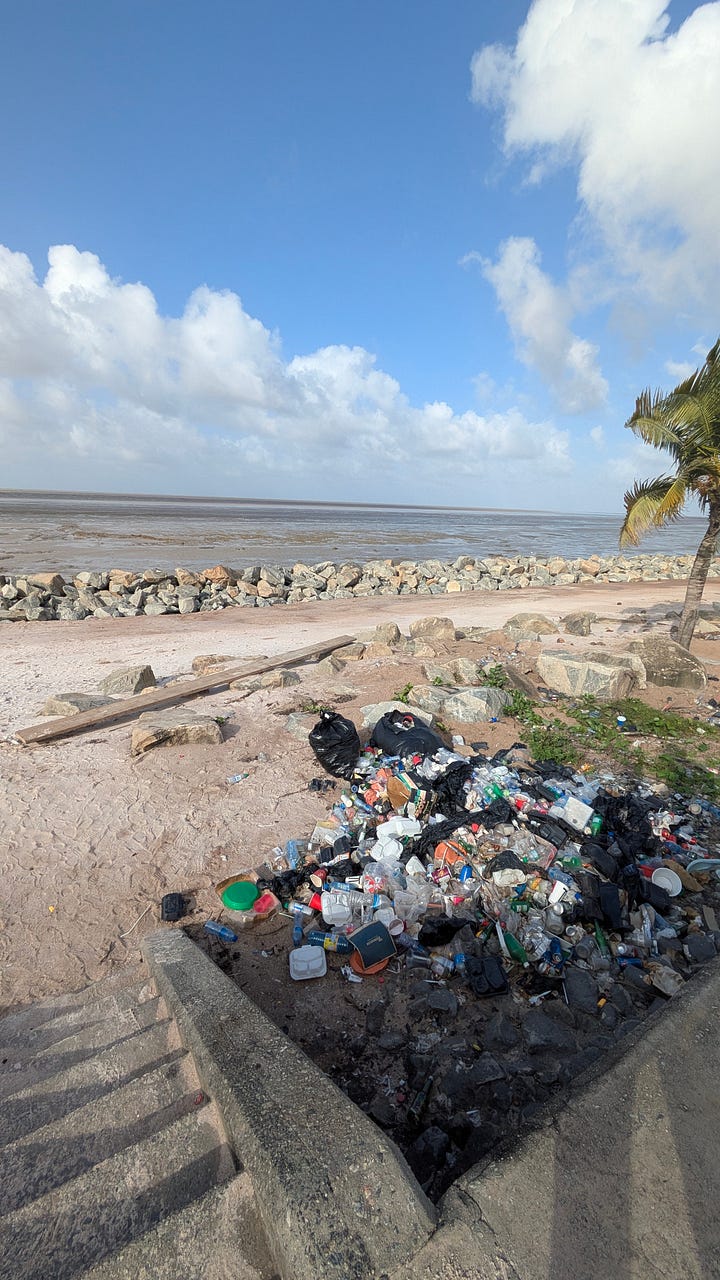
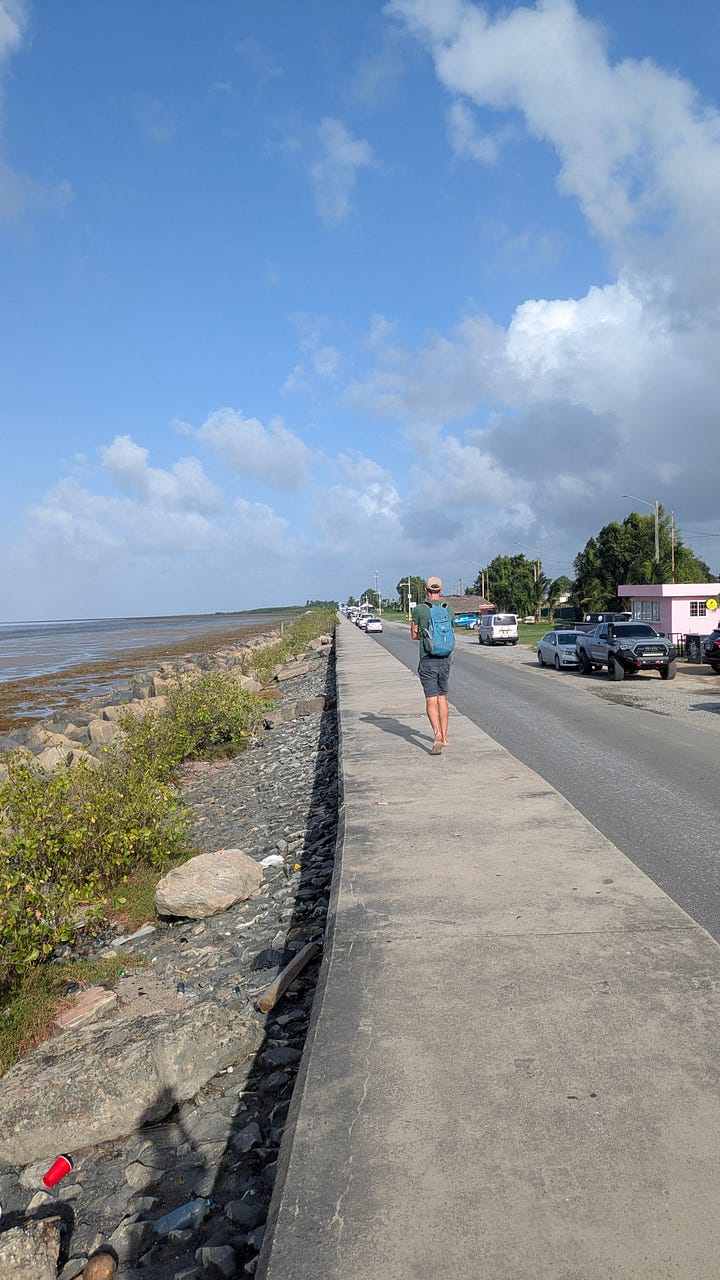
Next, we ticked off the cultural highlights: the “botanical gardens” (a handsome collection of overgrown weeds), national gallery (a few nice paintings, but mostly empty for renovation) and Guyana’s national museum.
The museum was the best of the bunch. When we walked in, a woman behind a desk shouted at us to get out, the museum was closed for lunch until 12.30pm. But it was 12.36, I pointed out. “Look at the clock, see the time and get out,” she said. Sure enough, her clock said 12.27. It was wrong, but I wasn’t prepared to argue. We stepped outside, waited a cautious four minutes and tiptoed back in. “Welcome to the National Museum of Guyana,” the same woman said. “Exhibitions start upstairs. No pictures with flash.”
Aren’t crap museums often the best kind? This one was an eclectic mix of taxidermied sloths, historic maps and pro-oil propaganda. The final room was just a large storage space for all the things that had either been left in Guyana by the British or moved from past exhibitions that they didn’t know what to do with. A penny farthing leaned against the wall next to a model of an Apollo 11 rocket and an empty dolls’ house. The Exxonmobil-sponsored slideshow attempting to argue the environmental benefits of drilling for oil made me see red, but I did enjoy the maps room.
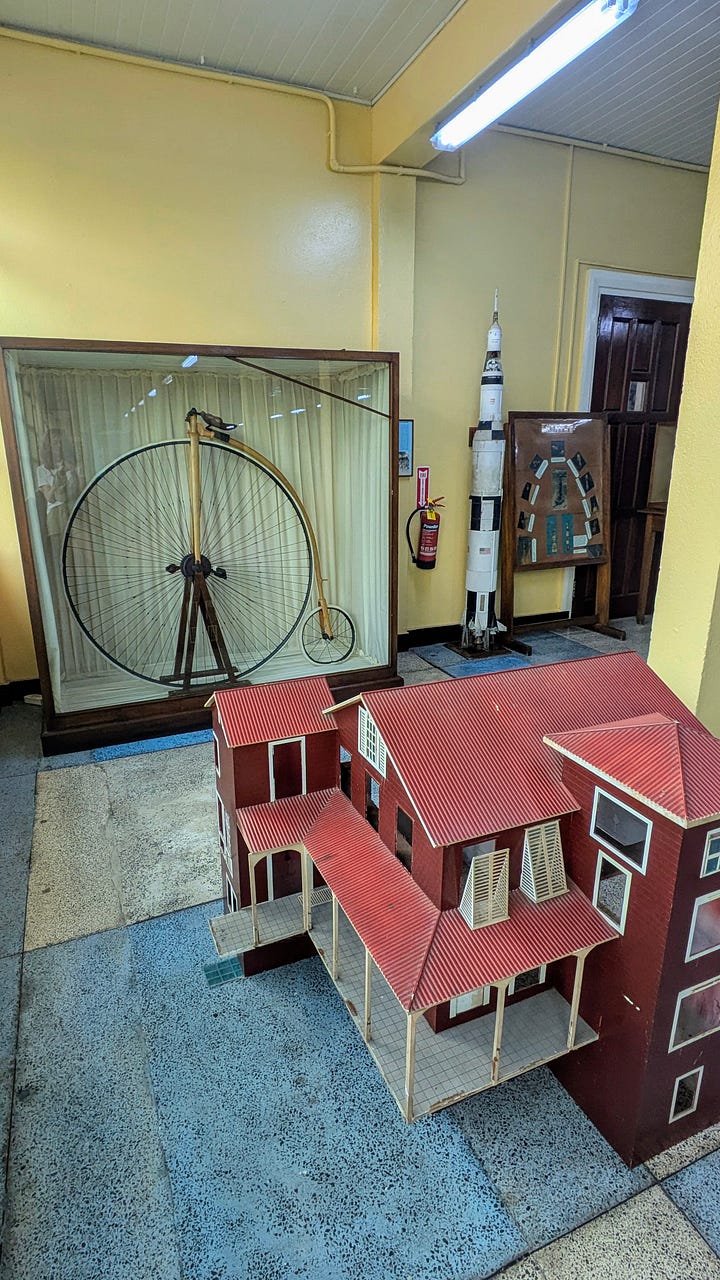
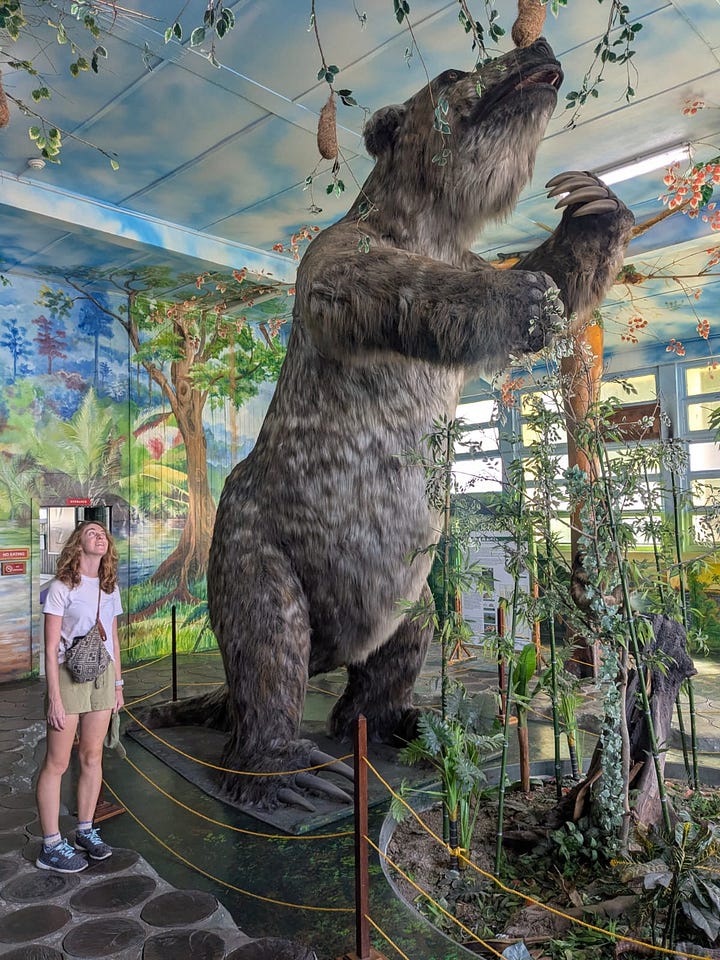
For more than 200 years, Guyana and Venezuela have disputed the border between them. By most world maps, the Essequibo territory (between the Essequibo and Orinoco rivers) is part of Guyana, but Venezuela maintains that it’s theirs – and after reading about it in the museum, I can empathise. The borders have shifted constantly throughout history, but much of the dispute seems to stem from one erroneous map drawn up by a French cartographer in the 18th century… this was back in the day when such things were measured by walking around on foot and making your best guess, so hardly surprising. Historic cartographers were absolutely wild for getting stuff wrong and just making things up. However I do feel what happened next is probably Britain’s fault.
In 1835 the Brits commissioned a German naturalist called Robert Hermann Schomburgk to survey the land boundaries, and it sounds like he was using the incorrect French map as a draft on which to base his own. Later, when he went to survey the region in person, he saw that the French map had drawn the border at the wrong river – thereby missing out the whole Essequibo territory, which is more than half of Guyana. Apparently Schomburgk corrected this in his own map once he realised, but the British didn't get round to publishing his corrections for another 50 years. In the meantime, Venezuela had discovered gold in Essequibo – and so they were more than happy to believe that the land was theirs all along.
The Brits did reinforce their borders after this, and somewhere along the way America got involved, but Venezuela hasn't been able to let it go. Just last year in March, the Venezuelan government passed a law declaring Essequibo a new state. I guess claiming or reclaiming land doesn’t quite work that easily, and so the dispute continues.

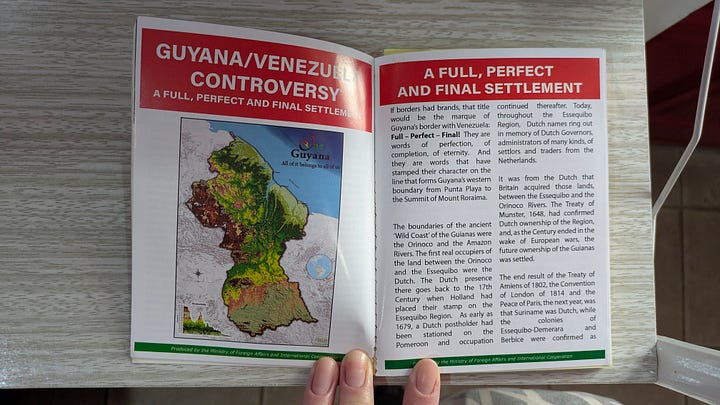
Along with gold, oil, gas, gold, diamonds, bauxite, and other minerals reserves, the Kaieteur Falls happen to sit within the Essequibo territory – so if we were to make it there for a tour, some people would argue we'd made it to Venezuela on this trip after all… But what about the flights, I hear you ask? Yes, about those. After much pestering on Dave’s part, we still had no confirmation from those cowboys at Air Services Limited that the Saturday trip was going ahead. They finally replied on Friday to say they were cancelling on account of there being too little interest.
The same day, we checked in with our other agency regarding the Sunday flight, since they’d started ghosting us as well. John from Evergreen Adventures came back with bad news: flights for the weekend were “cancelled due to emergency maintenance of aircraft” which sounded pretty conclusive.
Having been initially unsure about spending the cash, this double rejection left us feeling deflated. But we were in the city now and had the advantage of being to walk into travel agencies to bother them face to face, starting with Wanderlust Adventures, a shiny outlet off the main street. A friendly woman offered us free bottled water but lamented that she couldn’t help us – the town was busy with the conference and the carnival and everything they had was booked up.
This made total sense, but it seemed strange given that the first agency claimed not to be able to summon enough interest to charter a plane. Suddenly I realised the cold, hard truth: we’d been bumped off the list because of the conference. Clearly we were being relegated from the queue in favour of some ambassador and his party, or an oil company boss here to see the natural wonders they were helping to destroy.
Down the road, Dagron tours (not a typo) said they were putting on an extra flight for the Sunday due to high demand – it should be going ahead and they’d have a space for us, but they were waiting for two other people to get back to them to confirm their spots. They said they’d get back to us to confirm by 4pm. We heard nothing.
We went for a curry at Aagman, an unassuming restaurant that looked like a squat from the outside and an interior design showroom inside. Dagron said they'd get back to us by 8am, ie, the morning of the flight and the day of our check out. We’d already booked an extra night in the city to accommodate for the potential Sunday trip, but there would be nowhere to stay beyond that, since Sunday was the kick off for the carnival.
At 9.49am on Sunday morning, 11 minutes before the alleged flight was scheduled to leave, we finally heard back from Dagron: the flight wasn’t happening. We told them we’d figured as much and proceeded to pack up our stuff.
Except – curveball! There was a missed call from John at Evergreen (the one with the broken aeroplane) saying they had a flight scheduled, would we like to join after all? And so we dropped everything, told the Airbnb host to suck it, and hitched a cab to the terminal.
No, not really. John did call, that part is true – but after a brief conference, Dave and I and decided that actually, we were done with the drama of it all. Any excitement had been replaced by frustration and logistical admin stresses – to pay $650 USD between us at this late stage for a trip on a plane that had been too broken to fly until a couple of hours ago all felt like the wrong vibe. We were over it, we decided, and took ourselves back to the Oasis Café for one last time to strategize our exit from Georgetown.
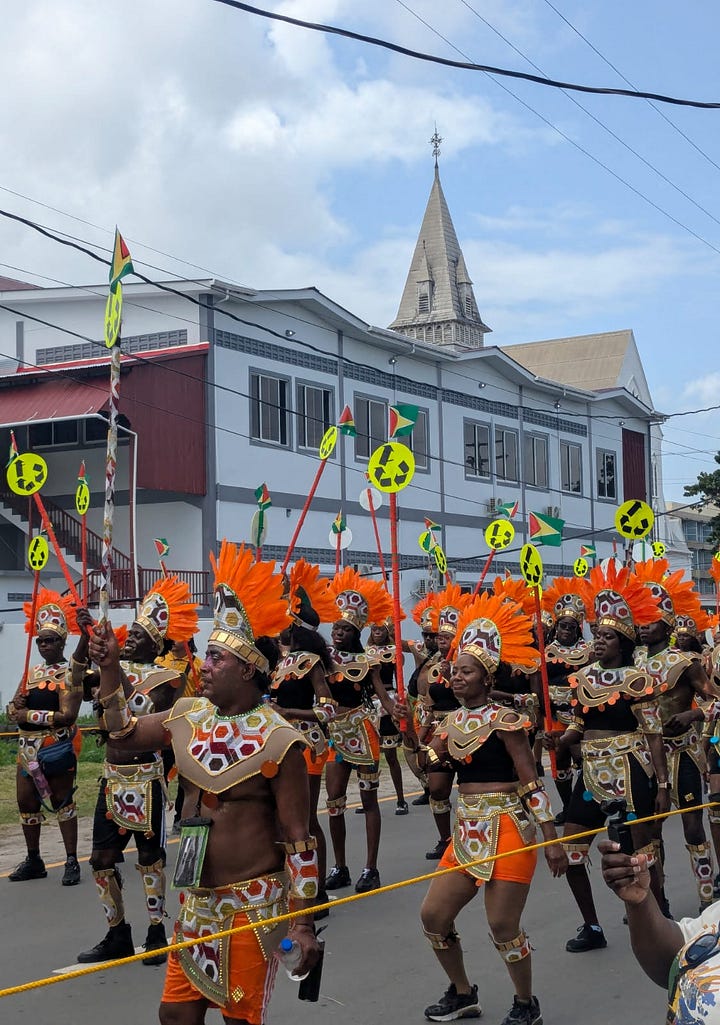
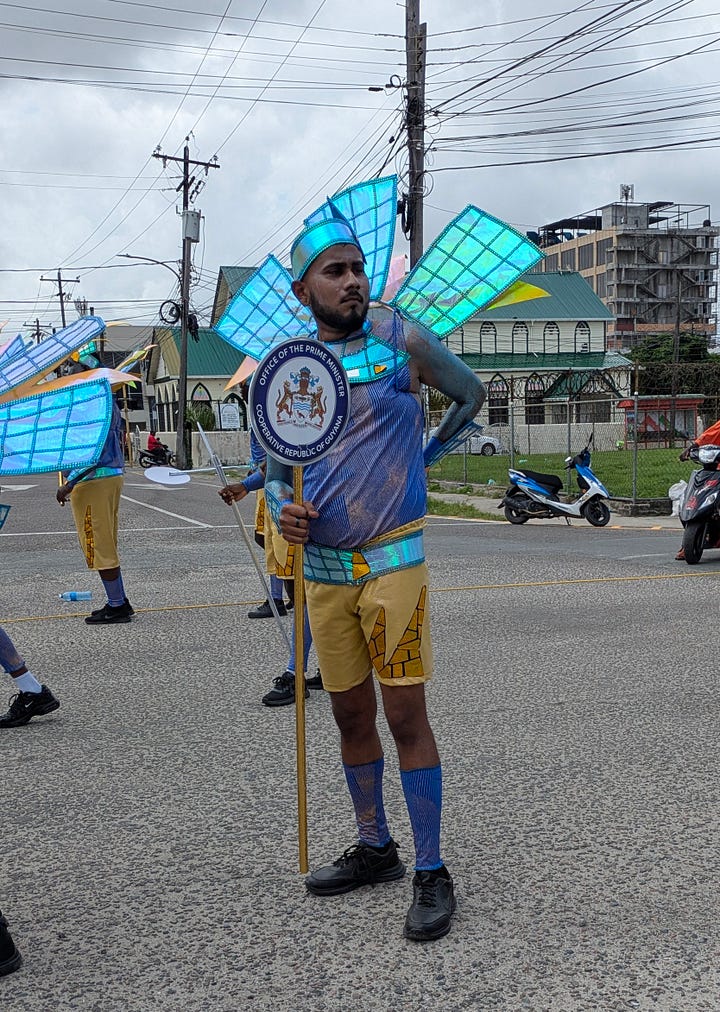
It was impossible to feel down about the plane saga when Mashramani, Guyana’s biggest carnival, was kicking off in town. If you happen to have lived or grown up in a small English town then chances are you’ll have been exposed to its annual parade. In Felixstowe we had the Felixstowe Float; apparently in Lichfield it’s the Lichfield Bower. If you live in London or a similarly large and metropolitan city, don’t even try to come at me – we’re not including Notting Hill Carnival in this bracket, it is simply not comparable.
I’ll admit it’s been a very long time since I sat on the back of an empty lorry (articulated truck, for the global readers) dressed as a clown as it travelled in convoy through the villages of Trimley St Mary and Walton. Maybe someone can tell me if the aesthetic has changed at all since 1999, but for inexplicable reasons the town’s scouts, brownies, shop owners and church groups came out in force to decorate a “float” and compete for prizes such as “best lorry”, “best majorettes/dance group” and “best in show”. And of course, there is an annual beauty queen – I gather that anyone who has lived in the village long enough has had their turn as “Miss Trimley”, “Miss Walton” or “Miss Felixstowe”. Presumably there is some charity fundraising aspect to it all, too.
Anyway, picture the Felixstowe or Lichfield carnival, but with the addition of all the UK’s government department employees. And instead of being dressed as clowns or tudor monarchs, the employees are in their feathers and thongs, taking part in expertly curated dance routines honed over the year in anticipation for this day and twerking at giant effigies of their respective department ministers.
The float for Guyana’s department of health was a riot of stethoscopes twirling around necks; the ministry for waste disposal was inspired by the city's recycling incentive. Everyone involved was absolutely living for their moment. At one point we saw a small crowd gathered around a man dancing in a colourful shirt and stopping for photos – I said to Dave, semi-joking, “I bet that's the president”. When we saw the news later, we realised it actually was him.
When we’d had enough, we took ourselves to Greaves Transportation Services to secure ourselves a spot in a shared minivan down to Iwokrama – just more than halfway between Georgetown and Lethem on the southern border with Brazil – where we’d planned to stay a couple of nights at the Iwokrama River Lodge. This, we knew, was going to be a rough journey – the roads through most of Guyana south from the coast range from bad to non-existent. This was part of the reason why we’d opted to get out at Iwokrama and break up the journey. But nothing could have prepared me for just how rough going it would be. Dirt tracks with trenches in them deep enough to house a family; drivers who showed no mercy – it was all I could do just to hold on to the floor, roof or ceiling and try not to be sick for ten hours straight.
The driver allowed us one brief stop at a roadside diner where truck drivers played pool while sex workers watched on. We were starving by this point, so Dave and I grabbed a bit of food but I didn’t eat much of it because I was worried it wouldn’t stay down… ten minutes of respite and we were back on the road, the driver now playing some kind of techno-reggae at full volume with the windows open to keep himself (and the rest of us) awake. At 2am, we finally pulled up outside a house with hammocks strung outside it. It was pitch dark since the owners and tenants had all gone to bed presumably long before we’d woken them up with the techno-reggae.
At no point during our journey did the driver speak to any of us or give a hint as to what was happening. When we arrived at hammock villa, he disappeared into the darkness without a word – presumably he had a warm bed waiting for him somewhere. I wouldn’t have had a clue what was happening or what to expect for much of this strange journey in fact if it wasn’t for a blog entry we’d read from a lovely British couple we met months ago in Argentina. Heidi and Nigel had taken this route in reverse some months before us, and it was thanks to Peace Around the World (great name for a blog because it’s their surname) that Dave and I knew to expect a pause in proceedings like this where we’d be able to grab a couple of hours’ sleep. Annoyingly, our own hammocks were inaccessible along with the rest of our stuff (tied up on the roof of the van) and with the driver gone we had to wake up a small lady to rent us a couple of hers for a few dollars.
Frustratingly, we were only a couple of kilometres away from the lodge at this point, which was just across the river – but to cross the river required a raft that only operated from 6am. I was so exhausted from the journey so far that I did get a couple of hours’ sleep before waking up around 5am to someone shouting at us to hurry up and get back in the minivan – it was time to go.
Crossing the river was a case of driving onto a small floating platform that looked like it could have been made from plastic bottles and hoping it could carry the weight of our overloaded van. The river also marks the border of Essequibo, that huge disputed land, so we had to show our passports for police checks, but they seemed satisfied that we weren’t Venezuelan spies and allowed us on our way.
A few minutes later, we were at the Iwokrama River Lodge, where breakfast was waiting along with a much needed bed and shower.


We enjoyed a restful two days at Iwokrama. Most people who stay there do so as part of a package deal with a set number of tours included (hikes through the forest, your classic caiman spotting boat rides, etc) but we felt we'd already had some wonderful– and much better value – jungle experiences like that in Brazil and Peru, so we were happy just to spend the majority of our time relaxing on the terrace with a view over the river. From this viewpoint we watched agoutis and caiman, I got to know some scarlet macaws who lived in the trees close to the dining area, and once we saw a grey crab-eating fox peg it across the grass and into the trees.
There are plenty of trails around the lodge, but supposedly visitors are not allowed to walk them without a guide. However, when we asked about it, the nice woman in charge of the office hinted that nobody would stop us if we were to go out on our own – and at any rate she could tell we were poor. While most guests stayed in individual cabins, Dave and I had selected the cheapest sleeping option – in the staff lodgings. Our tiny room fit very little other than our twin beds but it still felt like luxury after the hellish night we'd spent journeying down there – and I like to think we built up a bit of a rapport with the service staff in the neighbouring rooms around us as a result. This feeling was cemented when our friend in the office told us that one of the staff was driving out to Lethem – the border town we were heading to – on the morning of our departure. For a snip of the price of the usual tourist transfers, he'd save us a seat along with some of the other staff members heading home for their time off (most lived out towards the town or in neighbouring villages, working a rota of two weeks on, one week off).
And so, on our final morning in Guyana, we rose with the birds at 4:50am for the final leg of the journey back to Brazil. Sleeping in a pile of bags, food packages and families, we listened to the driver's chosen song, “The Holy Ghost Power is Moving Just Like a Magnet” on repeat for four hours, but I'd take it over the techno we endured all night on the way out here.
Bleary eyed and with much lighter pockets, we’d come to the end of our 3.5-week whirlwind tour of the Guianas. Guyana had been a challenging one, for sure – it's strange to say it, but it was the country where we had the biggest problems with communication. The English spoken is Creole, which is really a different language entirely – but unlike Portuguese or Spanish, you can’t refer to Google Translate for help.
I struggled both to understand and be understood in a lot of situations in Guyana, but we had some very enjoyable moments, too. I was glad to have seen some of the stunning natural interior, and I have to say the food we had in Georgetown was all excellent: pepperpot stew, BBQ wings (and veggie burgers for me), plus some of the best vegetarian curries I've had – from a deli that Dave found opposite a prison, of all places, near our accommodation on the first night.
Even so, we were excited to cross back into Brazil: for a final stint in Manaus to pay our fines, for some low price toiletries shopping, and for some enormous, much anticipated Brazilian buffets.
Travel bits and tips from this week
In Georgetown, we enjoyed meals at the Fireside Grill and Chill, Aagman Indian restaurant, Shantas Puri Shop, Kiskar Veggie Hut, and of course the Oasis Café.
We found a very cool little bar in our neighbourhood, the Guerilla Nanobrewery, run by a Chilean man, and I also enjoyed the coffee at Deja Brew Café.
We took the minivan south from Georgetown via Greaves Transportation Services. It was a bit horrible, but mostly due to the roads, and there's no smoother option. All the transfers along this route go all the way from the city to Lethem in one go (with a brief hammock stop by the river crossing) and annoyingly most places will charge for the price of the full route even if you jump out halfway like we did. Greaves offered a bit of a discount so it was worth it even with the horrible driver.
We stayed at the the Iwokrama River Lodge, which we liked because it's accessible from the main road and it had a good range of sleeping options from luxury to basic (ie. Staff quarters – which were absolutely great!). There are other lodges around with various package deals but the private transfers to get to them can be wildly expensive.
If you're planning a trip to Guyana, get in touch and I'll be glad to share all the details including costs!

